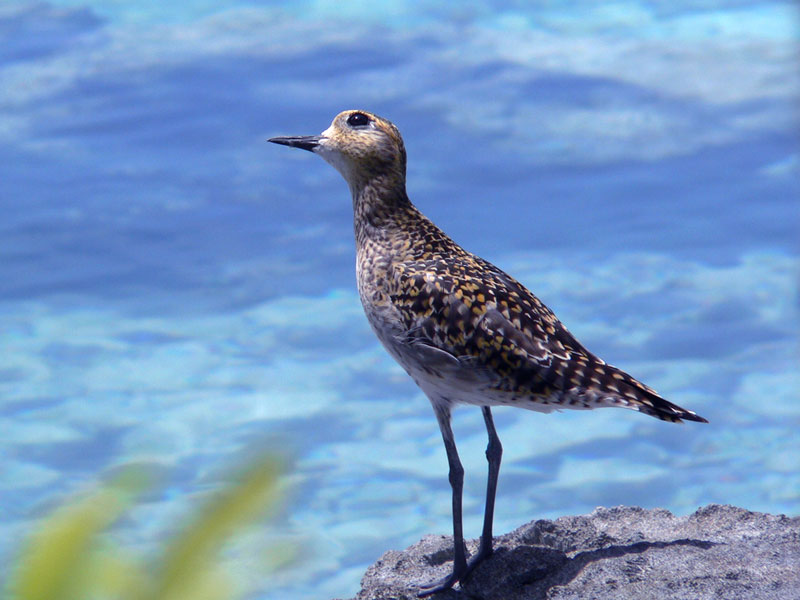Published in the Ocean Watch column, Honolulu Star-Advertiser © Susan Scott
August 31, 2009
The message that winter is coming is loud and clear in my neighborhood this week, and it sounds like chu-EET! Our kolea are back.
The earliest golden plover sighting reported to me this year came from a Wahiawa reader on July 26.
“It was still dressed up in what I think of as its spring courting plumage,” Dianne wrote.
A Kailua friend e-mailed me Aug. 18 about seeing his first plover of the season.
“Seems early,” he wrote, “but I guess winter is just around the corner.”
I replied that these early birds are the males. But that’s wrong. The females arrive first, males arrive next and the last to come are the juveniles, most in October.

After discovering my mistake, I looked up other differences between male and female plovers. I also checked on the timing of their molts.
When it comes to raising chicks, the work for both sexes is about equal. Both arrive at the Arctic breeding grounds at the same time. The males get to work right away, each establishing a territory of 60 to 120 acres by making several rudimentary nests in the area. The male advertises his subdivision by calling out while flying over it, using rapid shallow wing beats called a butterfly display.
Within three days of watching the aerials and looking over the construction sites, each female chooses a partner. Mating takes one to four seconds. (In the short Arctic summers, these birds can’t afford dawdling.) Then the pair gets to work on the nursery.
The birds use grass, leaves, sticks and stones for the outside of the nest, typically 5 inches wide and 2 inches tall, and line the inside with 60 to 250 pieces of lichen, up to an inch thick.
Both sexes defend the homestead and share egg-sitting duty. Males get the day shift; females work graveyard. After the chicks hatch, parents carry the broken eggshells to locations far from the nest so as not to broadcast the site to lemmings, ravens and other predators.
Plover chicks are born mobile and immediately start running around with their parents, the family stabbing bugs and picking berries together.
Once in Hawaii, though, it’s every bird for itself. Both sexes of all ages fight, sometimes ferociously, for territory.
Plovers start returning to Hawaii in August because winter is approaching by then and the bugfest is winding down. The juveniles stay later to fatten up on whatever they can find.
Adult kolea arrive in their bright breeding colors, but not for long. Molting starts soon after they get here, and by December most have changed into their basic winter grays and browns. Come spring, they molt again, dressing up for the mating season in stunning colors that remind us Hawaii residents summer is approaching.
And people say we don’t have seasons.
My details about our migratory shorebirds come from an outstanding online publication called “The Birds of North America,” by the Cornell Lab of Ornithology.
Every time I look up facts in this volume, I learn something new and interesting. And when I look up facts I looked up in the past and forgot, well, then they’re new and interesting, too.
Anyone can read, download or print any part of this 18,000-page work at bna.birds.cornell.edu/bna. The cost is a bargain: $5 for 30 days, $42 for a year. But you probably shouldn’t take my word for it.